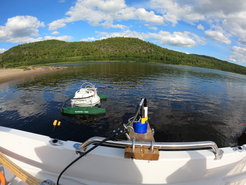
Arctic freshwater carbon dynamics
Lead: Judith Vogt
Arctic freshwater carbon dynamics
Freshwater ecosystems such as lakes and rivers emit large quantities of carbon dioxide and methane to the atmosphere on a global level [1,2]. For Arctic regions, especially where permafrost is present and thawing is accelerating due to global warming, emissions from existing and newly forming water bodies may alter feedback processes with climate [3]. However, the drivers of freshwater carbon emissions remain largely unknown, and flux estimates come with high uncertainties due to scarcity of 1) comprehensive observational data from northern regions, and 2) representation of heterogeneous processes in a quickly transitioning Arctic.

To advance our understanding of carbon fluxes between the water surface and the atmosphere, we are synthesizing existing observational data from spatially distributed chamber measurements, eddy covariance time series of carbon dioxide and methane, and other flux techniques within the Arctic-boreal domain. In addition, we seek to compile complementing information about water chemistry and site characteristics. The aim of this effort is to upscale the synthesized data to a pan-Arctic level and to update the data-driven estimate of freshwater contributions to the Arctic carbon budget. The final product of this comprehensive data synthesis will be made publicly available. One objective is to inform high-resolution process modelers about carbon flux drivers in the Arctic, but we hope the synthesized data will be useful to a wide range of data users. This work contributes to the projects Q-ARCTIC and GreenFeedBack.
If you would like to learn more or wish to collaborate, please contact us.

To fill existing gaps in data coverage and to actively contribute to the pan-Arctic synthesis, we conduct further field campaigns and collect measurements with floating chambers on lakes and rivers.
A recent field campaign in August 2023 focused on a natural river system in northern Fennoscandia to determine the carbon budget of the fast-flowing river Teno (Norwegian: Tana, Northern Sami: Deatnu). We measured carbon fluxes with a floating chamber from shore and from a small boat while drifting downstream, and obtained hydrochemical parameters of the water surface. With this dataset, we will be able to determine the vertical exchange of carbon dioxide and methane between the waterbody and the atmosphere.
In summer 2024, we measured carbon fluxes on various lake shores in Inuvik, Canada. With these measurements, we will determine spatial differences of lake emissions within the study region. A further field campaign with a focus on lakes will be conducted in 2025 to advance our understanding of small scale spatial flux variability.
References
- Raymond, P., Hartmann, J., Lauerwald, R. et al. Global carbon dioxide emissions from inland waters. Nature 503, 355–359 (2013). Global carbon dioxide emissions from inland waters | Nature
- Rosentreter, J.A., Borges, A.V., Deemer, B.R. et al. Half of global methane emissions come from highly variable aquatic ecosystem sources. Nat. Geosci. 14, 225–230 (2021). Half of global methane emissions come from highly variable aquatic ecosystem sources | Nature Geoscience
- Miner, K.R., Turetsky, M.R., Malina, E. et al. Permafrost carbon emissions in a changing Arctic. Nat Rev Earth Environ 3, 55–67 (2022). https://doi.org/10.1038/s43017-021-00230-3

